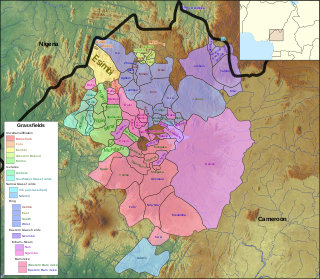Related Research Articles

Niger-Congo is a hypothetical language family spoken over the majority of sub-Saharan Africa. It unites the Mande languages, the Atlantic-Congo languages, and possibly several smaller groups of languages that are difficult to classify. If valid, Niger-Congo would be the world's largest in terms of member languages, the third-largest in terms of speakers, and Africa's largest in terms of geographical area. It is generally considered to be the world's largest language family in terms of the number of distinct languages, just ahead of Austronesian, although this is complicated by the ambiguity about what constitutes a distinct language; the number of named Niger–Congo languages listed by Ethnologue is 1,540.
Bikya is a potentially extinct Southern Bantoid language spoken in Cameroon. It is one of the three, or four, Furu languages. In 1986 four surviving speakers were identified, although only one spoke the language fluently.

Southern Bantoid is a branch of the Bantoid language family. It consists of the Bantu languages along with several small branches and isolates of eastern Nigeria and west-central Cameroon. Since the Bantu languages are spoken across most of Sub-Saharan Africa, Southern Bantoid comprises 643 languages as counted by Ethnologue, though many of these are mutually intelligible.
Semi-Bantu or Semibantu is an outdated and incorrect term used for languages spoken by the inhabitants of the Western grassfields of Cameroon which are Southern Bantoid languages, but don't belong to the Bantu language family but instead belong to the Grassfields language family.

The Beboid languages are any of several groups of languages spoken principally in southwest Cameroon, although two languages are spoken over the border in Nigeria. They are probably not most closely related to each other. The Eastern Beboid languages may be most closely related to the Tivoid and Momo groups, though some of the geographical Western Beboid grouping may be closer to Ekoid and Bantu.

The Grassfields languages are a branch of Southern Bantoid spoken in the Western High Plateau of Cameroon and some parts of Taraba state, Nigeria. Better known Grassfields languages include the Eastern Grassfields languages Bamun, Yamba and the Ring language, Kom, Nso, Oku, Bali, Bafut. Almost all of these languages are closely related, sharing approximately half of their vocabulary.
Busuu is an unclassified Southern Bantoid language of Cameroon. R Breton noted in 1986 that there were just 8 speakers left, while as of 2005 there were 3 speakers of the language. Busuu is an endangered language.
Kemezung is a Southern Bantoid language of Cameroon. According to Ethnologue, it's 85% lexically similar to Bebe.

The Bendi languages are a small group of languages spoken in Cross River State, southeastern Nigeria, with one (Bokyi) having some speakers in Cameroon. Once counted among the Cross River languages, Blench (2011) suggests that they may actually be a branch of Southern Bantoid, and observes similarities especially with the Ekoid languages.
The Furu languages are a proposed group of poorly attested extinct or nearly extinct and otherwise unclassified Southern Bantoid languages of Cameroon. Suggested Furu languages are:
Tikar is a Northern Bantoid language spoken in Cameroon by the Bankim, Ngambe and related Tikar peoples as well as by the Bedzan Pygmies. Variants of the name are Tikali, Tikar-East, Tikari, Tingkala.
Naki, or Munkaf, is an Eastern Beboid language of Cameroon and Nigeria. There is no name for the language; it is known by the villages it is spoken in, including Naki and Mekaf (Munkaf) in Cameroon and Bukwen and Mashi in Nigeria, the latter listed as separate languages by Ethnologue, though they are not distinct.
Mungbam is a Southern Bantoid language of the Lower Fungom region of Cameroon. It is traditionally classified as a Western Beboid language, but the language family is disputed. Good et al. uses a more accurate name, the 'Yemne-Kimbi group,' but proposes the term 'Beboid.'
Koshin is a Southern Bantoid language of Cameroon. It is traditionally classified as a Western Beboid language, but that has not been demonstrated to be a valid family.
Mundabli is a Southern Bantoid language of Cameroon. It is traditionally classified as a Western Beboid language, but that has not been demonstrated to be a valid family.
Mbuʼ, or Ajumbu, is a Southern Bantoid language of Cameroon. It is traditionally classified as a Western Beboid language, but that has not been demonstrated to be a valid family. Inasmuch as Western Beboid may be valid, Mbuʼ would appear to be the most divergent of its languages.
Saari, or Nsari, is an Eastern Beboid language of Cameroon. According to Ethnologue, it's 84% lexically similar to Ncane, making it very close to the Noni cluster.
Bebe, or Naami, is an Eastern Beboid language of Cameroon. According to Ethnologue, it's 85% lexically similar to Kemezung.
Chung (Cung) is an Eastern Beboid language of Cameroon.
Northern Bantoid is a branch of the Bantoid languages. It consists of the Mambiloid, Dakoid, and Tikar languages of eastern Nigeria and west-central Cameroon.
References
- ↑ Fang at Ethnologue (18th ed., 2015) (subscription required)
- 1 2 Good, Jeff and Lovegren, Jesse and Mve, Jean Patrick and Tchiemouo, Nganguep Carine and Voll, Rebecca and Di Carlo, Pierpaolo. 2011. The languages of the Lower Fungom region of Cameroon: Grammatical overview. Africana Linguistica 17. 101–164
- Blench, Roger, 2011. 'The membership and internal structure of Bantoid and the border with Bantu'. Bantu IV, Humboldt University, Berlin.
- Good, Jeff, & Jesse Lovegren. 2009. 'Reassessing Western Beboid'. Bantu III.
- Good, Jeff, & Scott Farrar. 2008. 'Western Beboid and African language classification'. LSA.
- https://www.acsu.buffalo.edu/~jcgood/Mve-2013-Fang.pdf